Simulation and Validation of Cisco Lethal Conditions in Minnesota Lakes under Past and Future Climate Scenarios Using Constant Survival Limits
Abstract
:1. Introduction
2. Materials and Methods
2.1. Simulation and Validation of Cisco Survival or Lethal Conditions Using Constant Survival Limits
2.2. Selection of 58 Virtual Lakes to Represent 620 Cisco Lakes in Minnesota
2.3. Long-Term Historic and Projected Cisco Lethal Conditions in 58 Virtual Lakes
2.4. Understanding/Extrapolating Cisco Lethal Potential in 620 Cisco Lakes
3. Results
3.1. Temperature and DO Model Calibration and Simulation in 23 Minnesota Lakes
3.2. Simulation and Validation of FishHabitat2013 for 23 Lakes in 2006
3.3. Simulated Cisco Lethal Conditions in 58 Virtual Lakes and 620 Cisoc Lakes
3.3.1. Results of Shallow and Medium-Depth Lakes
3.3.2. Results of Deep Lakes
4. Discussion
5. Summary and Conclusions
- (1)
- When the cisco habitat model used constant LT = 22.1 °C and DOLethal = 3 mg/L, simulated cisco kill (lethal conditions) and having cisco habitat in 2006 had overall good agreement with observations in 23 lakes (18 lakes with “Yes (Yes)” agreement and 4 lakes with partial or “Yes (no)” agreement) (Table 3).
- (2)
- Number of days with lethal conditions strongly depend on the strength of lake stratification (related to lake geometry ratio) and also have a non-linear complex relationship with lake trophic status (represented by Secchi depth) (Figure 9). The total number of years with cisco kill are 31–41 in northern shallow cisco lakes but less than 13 in northern medium-depth cisco lakes under the past climate conditions.
- (3)
- Under the future MIROC 3.2 climate scenario, shallow cisco lakes are projected to have cisco kill in almost every year with on average more than 30 kill days; medium-depth lakes are projected to have 25–47 years with cisco kill and on average 12–70 kill days. Therefore, shallow and medium-depth lakes are not good candidates for cisco refuge lakes.
- (4)
- Under the future MIROC 3.2 climate scenario, only relatively eutrophic deep lakes (Secchi depth <2 m) in northern and mid-latitude Minnesota and many southern lakes (Figure 12) have 5 or more years with cisco kill, and all other deep lakes are potential good refuge lakes. Cisco kill parameters cannot be used to classify 221 deep lakes into tiered refuge lakes, and other fish growth parameters should be used for future study.
Acknowledgments
Author Contributions
Conflicts of Interest
References
- Magnuson, J.J.; Crowder, I.B.; Medvick, P.A. Temperature as an ecological resource. Am. Zool. 1979, 19, 331–343. [Google Scholar] [CrossRef]
- Coutant, C.C. Temperature-oxygen habitat for freshwater and coastal striped bass in a changing climate. Trans. Am. Fish. Soc. 1990, 2, 240–253. [Google Scholar] [CrossRef]
- Christie, C.G.; Regier, H.A. Measurements of optimal habitat and their relationship to yields for four commercial fish species. Can. J. Fish. Aquat. Sci. 1988, 45, 301–314. [Google Scholar] [CrossRef]
- Jacobson, P.C.; Jones, T.S.; Rivers, P.; Pereira, D.L. Field estimation of a lethal oxythermal niche boundary for adult ciscoes in Minnesota lakes. Trans. Am. Fish. Soc. 2008, 137, 1464–1474. [Google Scholar] [CrossRef]
- Coutant, C.C. Striped bass, temperature, and dissolved oxygen: A speculative hypothesis for environmental risk. Trans. Am. Fish. Soc. 1985, 14, 31–61. [Google Scholar] [CrossRef]
- Fry, E.F.J. The Effect of Environmental Factors on the Physiology of Fish; Academic Press: New York, NY, USA, 1971; Volume 6. [Google Scholar]
- National Research Council. Changing Climate: Report of the Carbon Dioxide Assessment Committee; National Research Council (NRC), National Academy Press: Washington, DC, USA, 1983. [Google Scholar]
- Intergovernmental Panel on Climate Change. Climate Change 2007—Synthesis Report. The Fourth Assessment Report of the Intergovernmental Panel on Climate Change (IPCC); Cambridge University Press: Cambridge, UK; New York, NY, USA, 2007; p. 127. [Google Scholar]
- Blumberg, A.F.; Di Toro, D.M. Effects of climate warming on dissolved oxygen concentrations in Lake Erie. Trans. Am. Fish. Soc. 1990, 119, 210–223. [Google Scholar] [CrossRef]
- Fang, X.; Stefan, H.G. Simulations of climate effects on water temperature, dissolved oxygen, and ice and snow covers in lakes of the contiguous United States under past and future climate scenarios. Limnol. Oceangr. 2009, 54, 2359–2370. [Google Scholar] [CrossRef]
- De Stasio, J.B.T.; Hill, D.K.; Kleinhans, J.M.; Nibbelink, N.P.; Magnuson, J.J. Potential effects of global climate changes on small north-temperate lakes: Physics, fish, and plankton. Limnol. Oceanogr. 1996, 41, 1136–1149. [Google Scholar] [CrossRef]
- Magnuson, J.J.; Webster, K.E.; Assel, R.A.; Bowser, C.J.; Dillon, P.J.; Eaton, J.G.; Evans, H.E.; Fee, E.J.; Hall, R.I.; Mortsch, L.R.; et al. Potential effects of climate changes on aquatic systems: Laurentian Great Lakes and precambrian shield region. Hydrol. Process. 1997, 11, 825–871. [Google Scholar] [CrossRef]
- Stefan, H.G.; Hondzo, M.; Fang, X.; Eaton, J.G.; McCormick, J.H. Simulated long-term temperature and dissolved oxygen characteristics of lakes in the north-central United States and associated fish habitat limits. Limnol. Oceanogr. 1996, 41, 1124–1135. [Google Scholar] [CrossRef]
- Fang, X.; Stefan, H.G.; Eaton, J.G.; McCormick, J.H.; Alam, S.R. Simulation of thermal/dissolved oxygen habitat for fishes in lakes under different climate scenarios: Part 2. Cold-water fish in the contiguous US. Ecol. Model. 2004, 172, 39–54. [Google Scholar] [CrossRef]
- Jacobson, P.C.; Cross, T.K.; Zandlo, J.; Carlson, B.N.; Pereira, D.L. The effects of climate change and eutrophication on cisco Coregonus artedi abundance in Minnesota lakes. Adv. Limnol. 2012, 63, 417–427. [Google Scholar]
- Cahn, A.R. An ecological study of southern Wisconsin fishes, the brook silverside and the cisco, in their relation to the region. Ill. Biol. Monogr. 1927, 11, 1–151. [Google Scholar]
- Frey, D.G. Distributional ecology of the cisco, Coregonus artedi, in Indiana. Investig. Indiana Lakes Streams 1955, 4, 177–228. [Google Scholar]
- Sharma, S.; Zanden, M.J.V.; Magnuson, J.J.; Lyons, J. Comparing Climate Change and Species Invasions as Drivers of Coldwater Fish Population Extirpations. PLoS ONE 2011, 6, e22906. [Google Scholar] [CrossRef] [PubMed]
- Jiang, L.; Fang, X.; Stefan, H.G.; Jacobson, P.C.; Pereira, D.L. Identifying cisco refuge lakes in Minnesota under future climate scenarios using variable benchmark periods. Ecol. Model. 2012, 232, 14–27. [Google Scholar] [CrossRef]
- Coutant, C.C. Thermal Resistance of Adult Coho (Oncorhynchus kisutch) and Jack Chinook (O. tshawitscha) Salmon and the Adult Steelhead Trout (Salmo gairdnerii) from the Columbia River; BNWL-1508; Battelle Memorial Institute, Pacific Northwest Laboratories: Richland, WA, USA, 1970. [Google Scholar]
- McCormick, J.H.; Hokanson, K.E.; Jones, B.R. Effects of temperature on growth and survival of young brook trout (Salvelinus fontinalis). J. Fish. Res. Board Can. 1972, 29, 1107–1112. [Google Scholar] [CrossRef]
- Hokanson, K.E.; Kleiner, C.F.; Thorslund, T.W. Effects of constant temperatures and diel temperatures on specific growth and mortality rates and yield of juvenile rainbow trout, Salmo gairdneri. J. Fish. Res. Board Can. 1977, 34, 639–648. [Google Scholar] [CrossRef]
- Eaton, J.G.; McCormick, J.H.; Goodno, B.E.; O’Brien, D.G.; Stefan, H.G.; Hondzo, M. A field information based system for estimating fish temperature requirements. Fisheries 1995, 20, 10–18. [Google Scholar] [CrossRef]
- Dillon, P.J.; Clark, B.J.; Molot, L.A.; Evans, H.E. Predicting the location of optimal habitat boundaries for lake trout (Salvelinus namaycush) in Canadian Shield lakes. Can. J. Fish. Aquat. Sci. 2003, 60, 959–970. [Google Scholar] [CrossRef]
- Stefan, H.G.; Fang, X.; Eaton, J.G. Simulated fish habitat changes in North American lakes in response to projected climate warming. Trans. Am. Fish. Soc. 2001, 130, 459–477. [Google Scholar] [CrossRef]
- United States Environmental Protection Agency. Quality Criteria for Water; United States Environmental Protection Agency (US EPA): Washington, DC, USA, 1976.
- Chapman, G. Ambient Aquatic Life Criteria for Dissolved Oxygen; U.S. Environmental Protection Agency: Washington, DC, USA, 1986.
- Jacobson, P.C.; Stefan, H.G.; Pereira, D.L. Coldwater fish oxythermal habitat in Minnesota lakes: Influence of total phosphorus, July air temperature, and relative depth. Can. J. Fish. Aquat. Sci. 2010, 67, 2003–2013. [Google Scholar]
- Nash, J.E.; Sutcliffe, J.V. River flow forecasting through conceptual models part I—A discussion of principles. J. Hydrol. 1970, 10, 282–290. [Google Scholar] [CrossRef]
- Fang, X.; Jiang, L.; Jacobson, P.C.; Stefan, H.G.; Alam, S.R.; Pereira, D.L. Identifying cisco refuge lakes in Minnesota under future climate scenarios. Trans. Am. Fish. Soc. 2012, 141, 1608–1621. [Google Scholar] [CrossRef]
- Fang, X.; Alam, S.R.; Jacobson, P.; Pereira, D.; Stefan, H.G. Characteristics of Minnesota's Cisco Lakes; St. Anthony Falls Laboratory, University of Minnesota: Minneapolis, MN, USA, 2009. [Google Scholar]
- Gorham, E.; Boyce, F.M. Influence of lake surface area and depth upon thermal stratification and the depth of the summer thermocline. J. Gt. Lakes Res. 1989, 15, 233–245. [Google Scholar] [CrossRef]
- Stefan, H.G.; Fang, X. Simulated climate change effects on ice and snow covers on lakes in a temperate region. Cold Reg. Sci. Technol. 1997, 25, 137–152. [Google Scholar] [CrossRef]
- Stefan, H.G.; Fang, X. Model simulations of dissolved oxygen characteristics of Minnesota lakes: Past and future. Environ. Manag. 1994, 18, 73–92. [Google Scholar] [CrossRef]
- Stefan, H.G.; Hondzo, M.; Fang, X. Lake water quality modeling for projected future climate scenarios. J. Environ. Qual. 1993, 22, 417–431. [Google Scholar] [CrossRef]
- Fang, X.; Jiang, L.; Jacobson, P.C.; Fang, N.Z. Simulation and validation of cisco habitat in Minnesota lakes using the lethal-niche-boundary curve. Br. J. Environ. Clim. Chang. 2014, 4, 444–470. [Google Scholar] [CrossRef] [PubMed]
- Fang, X.; Alam, S.R.; Stefan, H.G.; Jiang, L.; Jacobson, P.C.; Pereira, D.L. Simulations of water quality and oxythermal cisco habitat in Minnesota lakes under past and future climate scenarios. Water Qual. Res. J. Can. 2012, 47, 375–388. [Google Scholar] [CrossRef]
- Fang, X.; Stefan, H.G. Development and Validation of the Water Quality Model MINLAKE96 with Winter Data; St. Anthony Falls Laboratory, University of Minnesota: Minneapolis, MN, USA, 1996. [Google Scholar]
- Thiery, W.; Stepanenko, V.M.; Fang, X.; Jöhnk, K.D.; Li, Z.; Martynov, A.; Perroud, M.; Subin, Z.M.; Darchambeau, F.; Mironov, D.; et al. LakeMIP Kivu: Evaluating the representation of a large, deep tropical lake by a set of one-dimensional lake models. Tellus A 2014, 2014, 21390. [Google Scholar] [CrossRef]
- Yao, H.; Samal, N.R.; Joehnk, K.D.; Fang, X.; Bruce, L.C.; Pieson, D.C.; Rusak, J.A.; James, A. Comparison of lake ice dynamics model performance: Harp Lake, Ontario, Canada. Hydrol. Process. 2014, 24, 4587–4601. [Google Scholar] [CrossRef]
- Hasumi, H.; Emori, S. K-1 Coupled GCM (MIROC) Description; Center for Climate System Research, University of Tokyo: Tokyo, Japan, 2004; p. 34. [Google Scholar]
- Bennis, S.; Crobeddu, E. New runoff simulation model for small urban catchments. J. Hydrol. Eng. 2007, 12, 540–544. [Google Scholar] [CrossRef]
- Cole, G.A. Textbook of Limnology, 3rd ed.; Mosby: St. Louis, MO, USA, 1994; p. 401. [Google Scholar]
- Joehnk, K.D.; Umlauf, L. Modelling the metalimnetic oxygen minimum in a medium sized alpine lake. Ecol. Model. 2001, 136, 67–80. [Google Scholar] [CrossRef]
- Smith, E.A.; Kiesling, R.L.; Galloway, J.M.; Ziegeweid, J.R. Water Quality and Algal Community Dynamics of Three Deepwater Lakes in Minnesota Utilizing CE-QUAL-W2 Models; U.S. Geological Survey Scientific Investigations Report 2014-5066; 2014; p. 37. Available online: http://dx.doi.org/10.3133/sir20145066 (accessed on 6 July 2016).
- Marshall, C.T.; Peters, R.H. General patterns in the seasonal development of chlorophyll a for temperate lakes. Limnol. Oceanogr. 1989, 34, 856–867. [Google Scholar] [CrossRef]


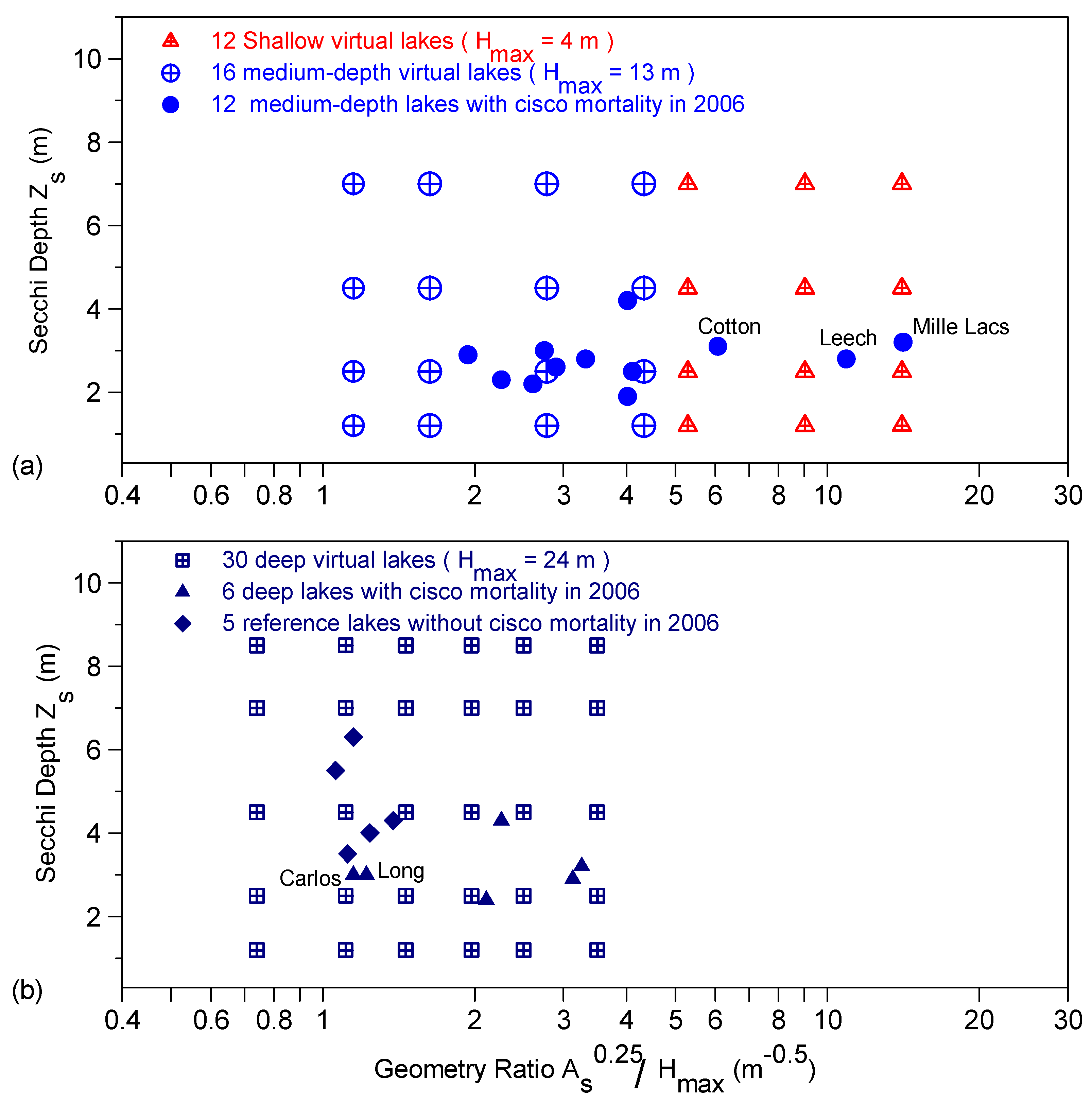
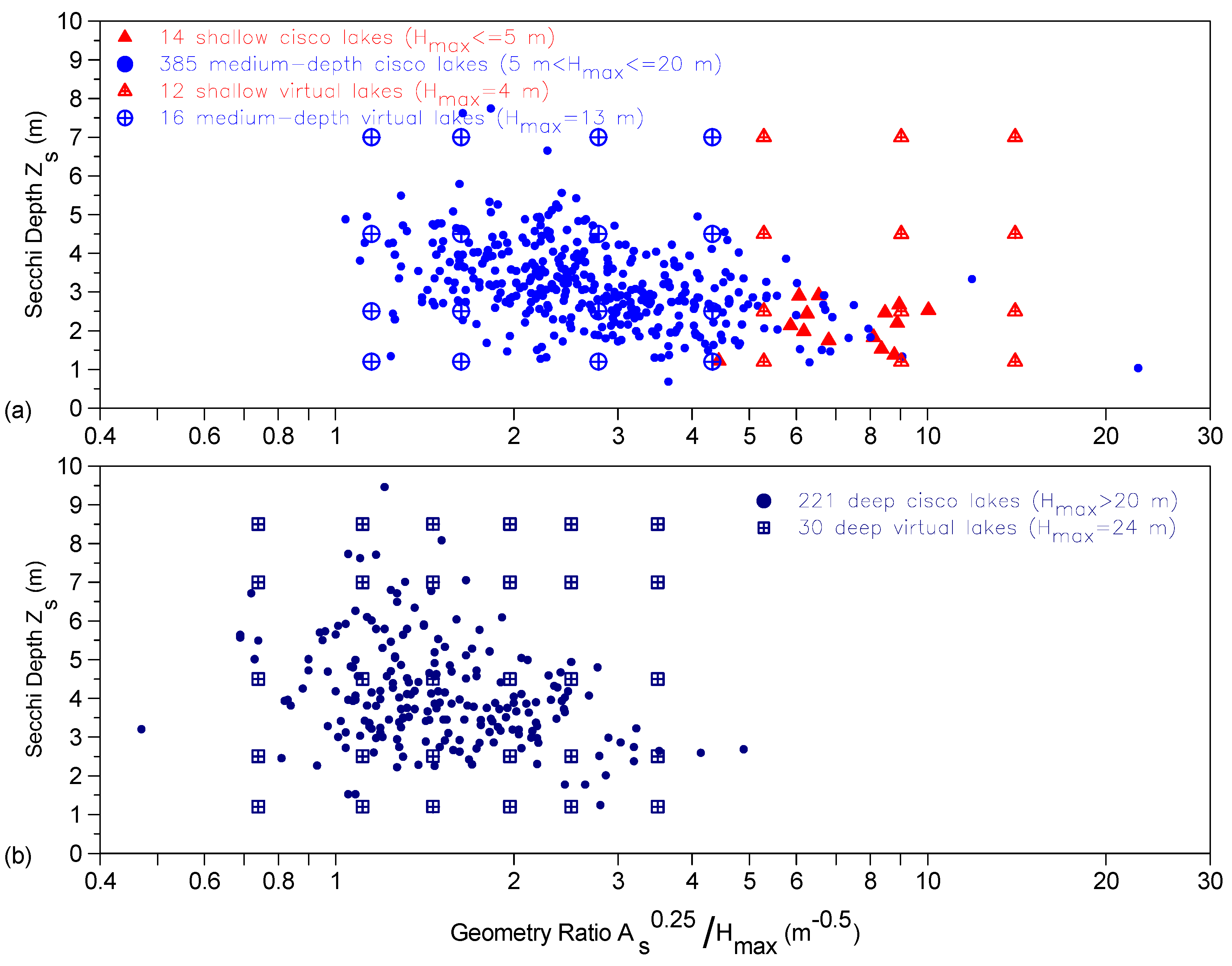

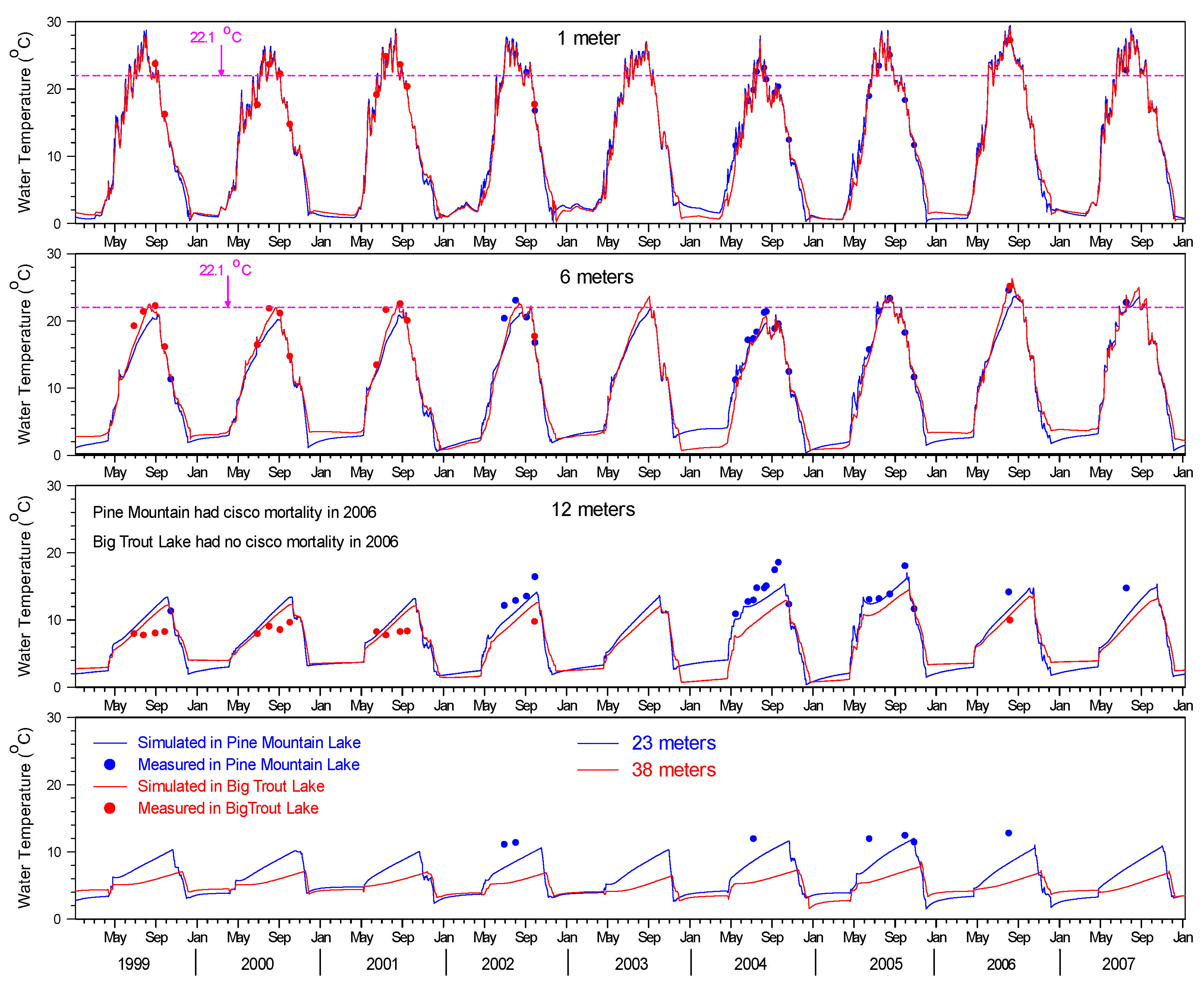

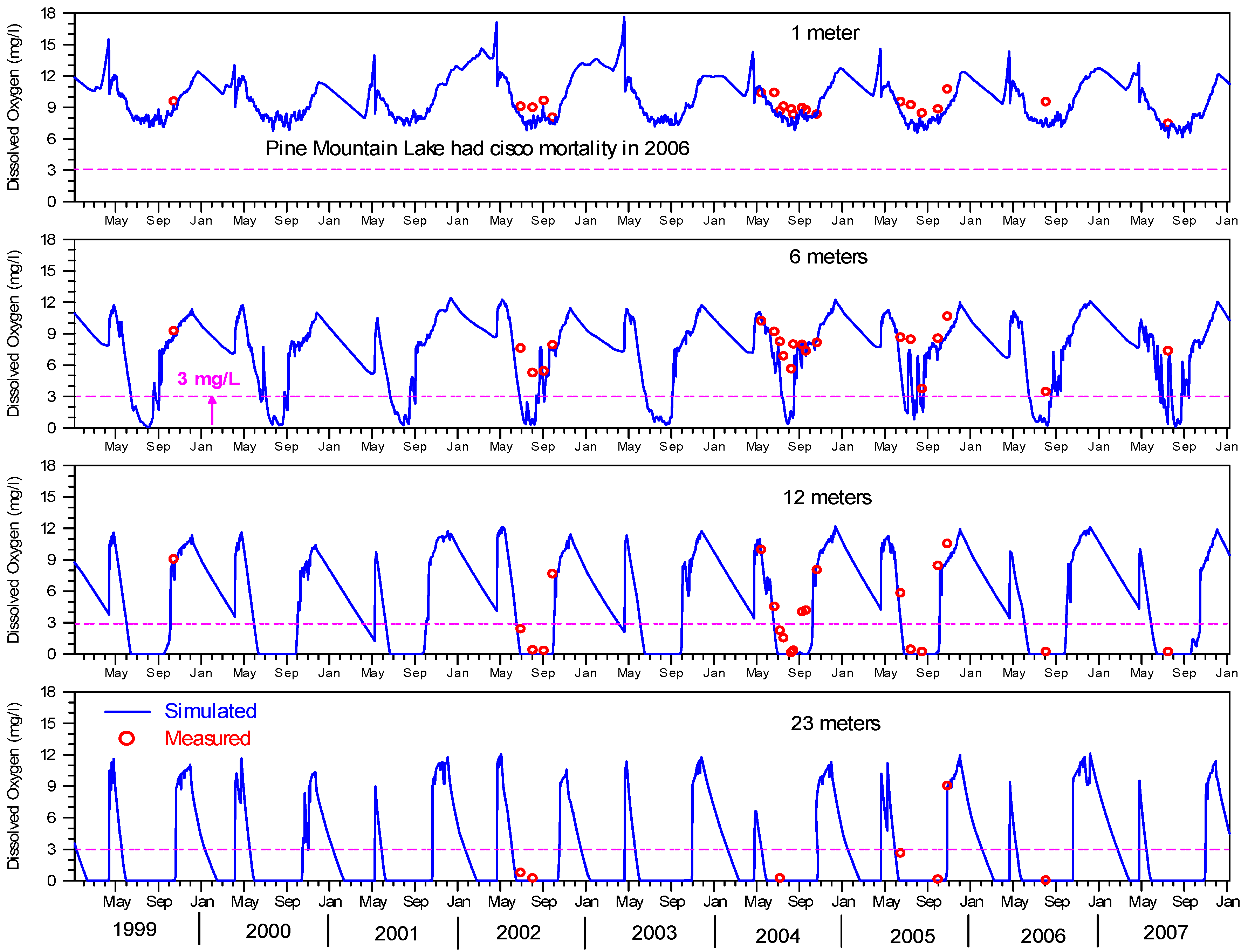
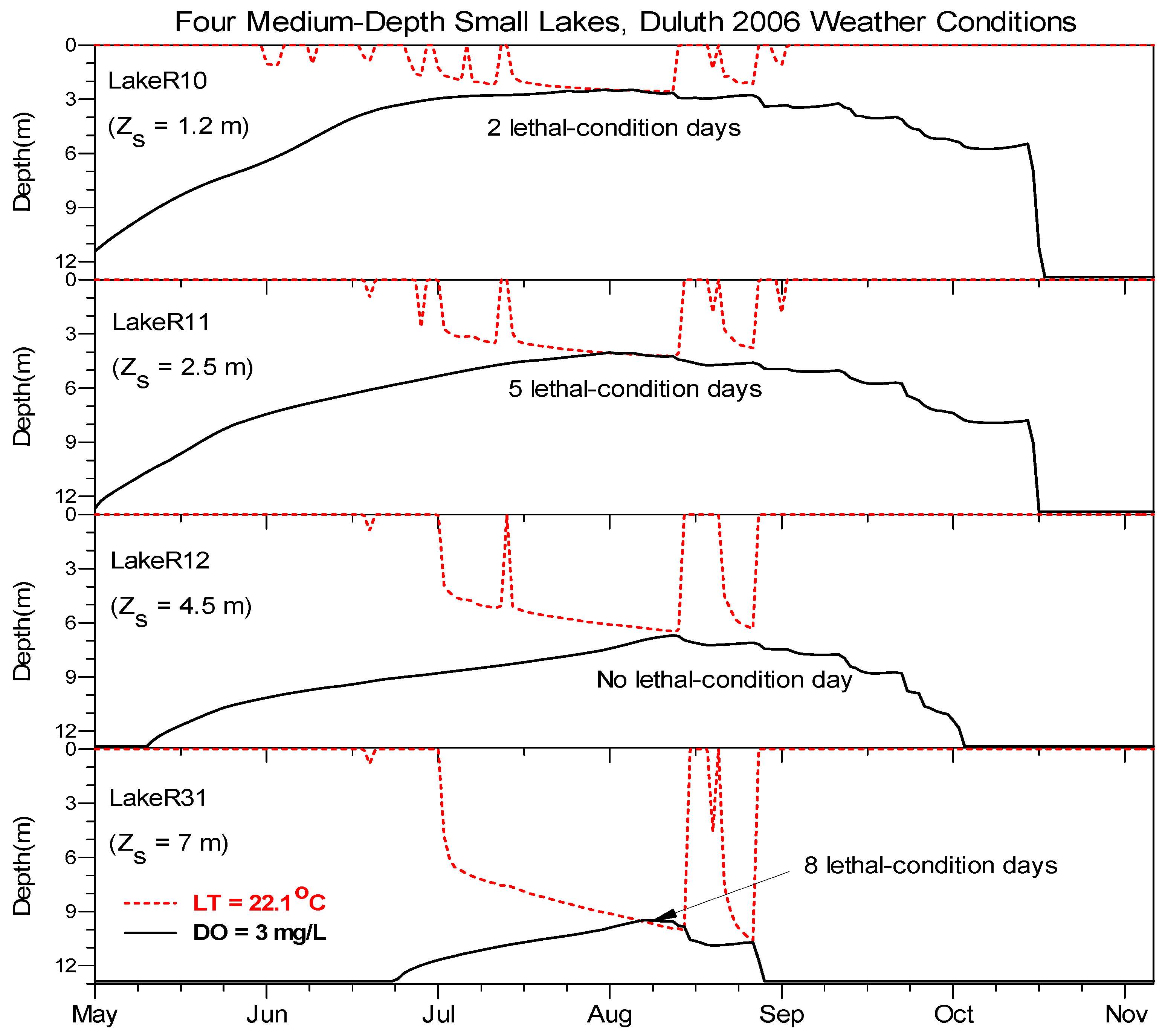

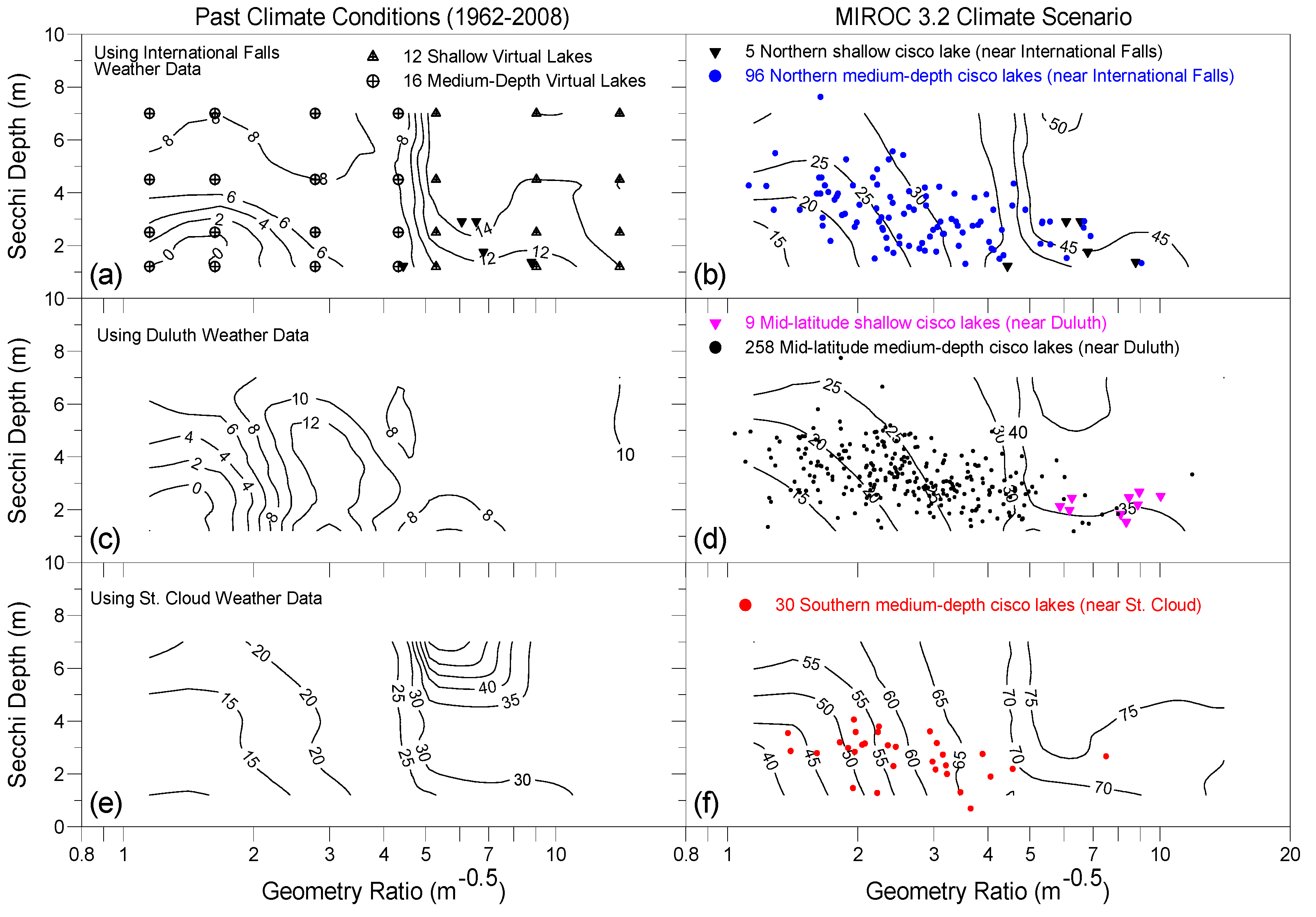
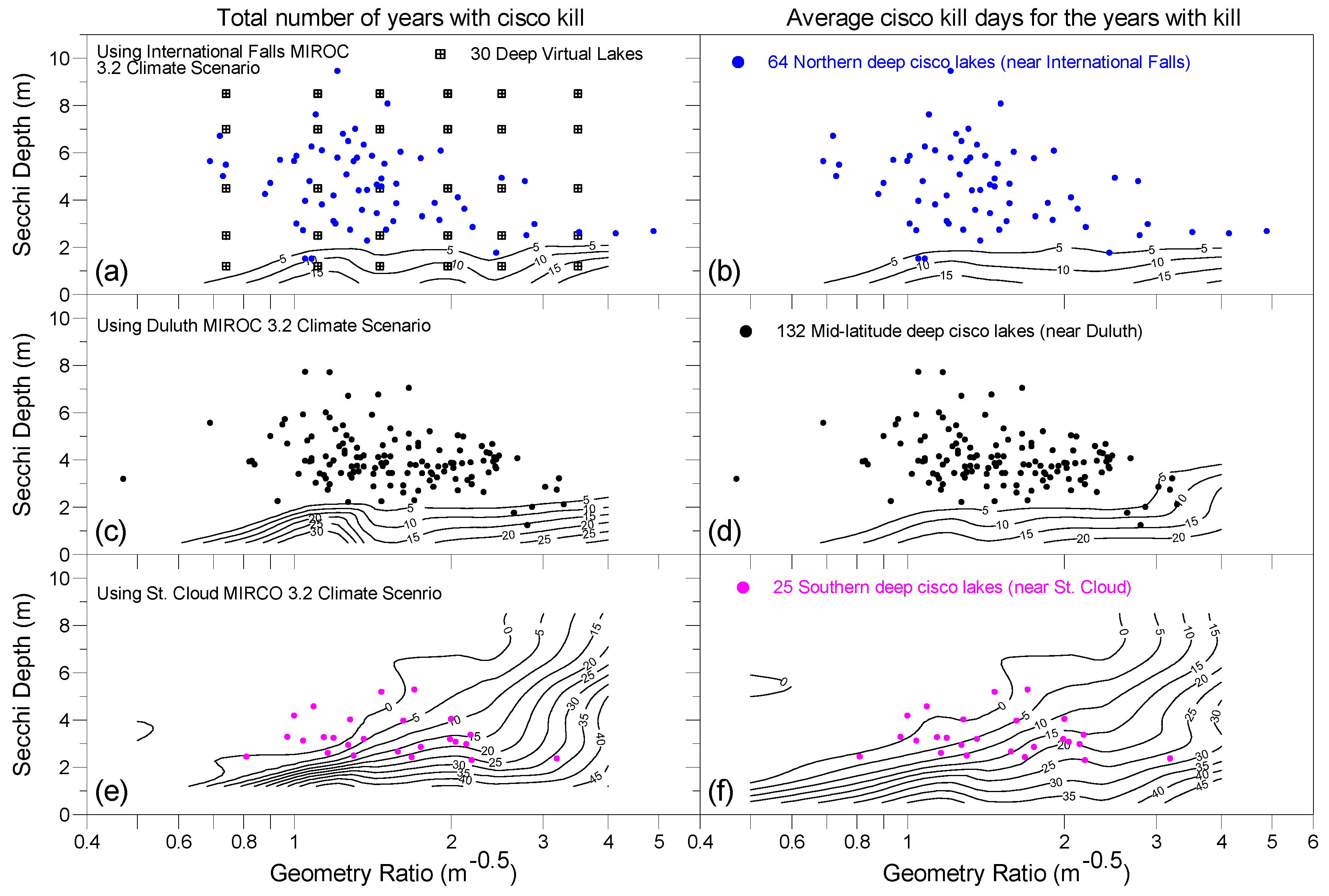
| Lake Name (Hmax (m), GR, (m−0.5)) 1 | Weather Station Used | Field Data Used in Simulation | T | DO | |||
|---|---|---|---|---|---|---|---|
| Years | Days (Data Pairs 4) | RMSE 5 | NSE 6 | RMSE | NSE | ||
| Little Turtle (8.8, 4.21) | Grand Rapids | 06 | 1 (14) | 0.34 | 0.90 | 2.27 | 0.48 |
| Star (28.7, 2.26) | Fargo | 73, 00, 06 | 3 (43) | 2.16 | 0.81 | 1.15 | 0.90 |
| Mille Lacs (13.0, 11.89) | Brainerd | 81,90–92, 00, 01 | 70 (699) | 1.88 | 0.86 | 1.30 | 0.17 |
| Andrusia (18.3, 2.75) | Bemidji | 76–78, 86, 06 | 11 (95) | 2.47 | 0.81 | 2.29 | 0.66 |
| Little Pine (19.2, 2.77) 2 | Fargo | 80, 85, 86, 06 | 6(100) | 1.97 | 0.77 | 2.71 | 0.50 |
| Cotton (8.5, 6.07) | Bemidji | 99, 06 | 5 (53) | 0.92 | 0.93 | 1.19 | 0.82 |
| Pine Mountain (24.4, 2.11) | Brainerd | 98, 99, 01, 02, 04–07 | 27 (519) | 1.85 | 0.82 | 2.58 | 0.58 |
| Leech (13.0, 10.91) | Bemidji | 06 | 1 (14) | 0.36 | 0.73 | 1.86 | −0.1 |
| Bemidji (23.2, 3.13) | Bemidji | 06 | 1 (23) | 2.08 | 0.88 | 0.84 | 0.95 |
| Itasca (12.2, 3.32) | Bemidji | 06, 08 | 18 (208) | 2.89 | 0.70 | 2.49 | 0.56 |
| Gull (24.4, 3.26) | Brainerd | 76–78, 89, 91, 92, 04, 06 | 31 (480) | 1.69 | 0.86 | 1.24 | 0.90 |
| Woman (16.5, 4.02) | Grand Rapids | 88, 01–04, 06 | 21 (392) | 2.10 | 0.81 | 1.99 | 0.60 |
| Straight (19.2, 1.94) | Bemidji | 06, 07 | 2 (33) | 0.88 | 0.98 | 1.36 | 0.93 |
| Little Pine (11.0, 2.90) 3 | Brainerd | 92–96, 98–02, 06 | 47 (465) | 3.61 | 0.53 | 2.46 | 0.63 |
| 7th Crow Wing (12.8, 2.49) | Bemidji | 06 | 1 (12) | 0.91 | 0.88 | 0.87 | 0.95 |
| 8th Crow Wing (9.1, 4.11) | Fargo | 73, 00, 06 | 3 (43) | 1.06 | 0.91 | 2.17 | 0.12 |
| Long (39.0, 1.22) | Fargo | 06 | 1 (18) | 0.83 | 0.97 | 1.17 | 0.90 |
| Carlos (49.7, 1.15) | St. Clouds | 79, 80, 86, 06, 08 | 17 (394) | 1.62 | 0.93 | 1.38 | 0.86 |
| Total or Average (above 18 lakes with cisco kill in 2006) | 266 (3605) | 1.65 | 0.84 | 1.74 | 0.64 | ||
| Reference lakes without cisco kill | |||||||
| Big Trout (39.0, 1.24) | Brainerd | 92–02, 06 | 47 (938) | 1.66 | 0.92 | 1.57 | 0.67 |
| Kabekona (40.5, 1.38) | Bemidji | 94, 06 | 6 (130) | 1.31 | 0.95 | 0.77 | 0.93 |
| Scalp (27.4, 1.15) | Fargo | 85, 86, 06 | 4 (75) | 1.25 | 0.97 | 2.89 | 0.57 |
| Ten Mile (63.4, 1.06) | Bemidji | 01, 02, 06, 08 | 95 (2771) | 1.60 | 0.91 | 1.50 | 0.69 |
| Rose (41.8, 1.12) | Fargo | 06 | 1 (25) | 0.68 | 0.99 | 1.59 | 0.80 |
| Total or Average (above 5 lakes without cisco kill in 2006) | 153 (3939) | 1.30 | 0.95 | 1.66 | 0.73 | ||
| Total or Average (all 23 lakes) | 419 (7544) | 1.57 | 0.86 | 1.72 | 0.66 | ||
| Maximum Depth (m) | Surface Area | Secchi Depth Zs (m) | Geometry Ratio | |||
|---|---|---|---|---|---|---|
| As (km2) | 1.2 | 2.5 | 4.5 | 7.0 | GR = As0.25/Hmax 1 | |
| Hmax = 4 (Shallow) | 0.2 | LakeR01 | LakeR02 | LakeR03 | LakeR28 2 | 5.29 |
| 1.7 | LakeR04 | LakeR05 | LakeR06 | LakeR29 2 | 9.03 | |
| 10 | LakeR07 | LakeR08 | LakeR09 | LakeR30 2 | 14.06 | |
| Hmax = 13 (Medium-depth) | 0.05 | LakeR37 2 | LakeR38 2 | LakeR39 2 | LakeR40 2 | 1.15 |
| 0.2 | LakeR10 | LakeR11 | LakeR12 | LakeR31 2 | 1.63 | |
| 1.7 | LakeR13 | LakeR14 | LakeR15 | LakeR32 2 | 2.78 | |
| 10 | LakeR16 | LakeR17 | LakeR18 | LakeR33 2 | 4.33 | |
| Lake Name | Lethal Conditions | Simulated Continuous Lethal Days in 2006 | Cisco Mortality Day (Julian Day) | Model Agreement | ||
|---|---|---|---|---|---|---|
| First Day | Last Day | No. of Days | ||||
| Little Turtle | 180 | 241 | 62 | 180 (62) 3 | 7/19 (200) | Yes (Yes) 4 |
| Star | 204 | 216 | 13 | 204 (13) | 7/19 (200) | Yes (No) |
| Mille Lacs | 204 | 251 | 48 | 204 (48) | 7/23 (204) | Yes (Yes) |
| Andrusia | 192 | 250 | 59 | 192 (59) | 7/21 (202) | Yes (Yes) |
| Little Pine 1 | 202 | 216 | 15 | 202 (15) | 7/22 (203) | Yes (Yes) |
| Cotton | 184 | 241 | 58 | 184 (58) | 7/24 (205) | Yes (Yes) |
| Pine Mountain | 193 | 250 | 53 | 193 (36); 232 (13); 247 (4) | 7/26 (207) | Yes (Yes) |
| Leech | 188 | 225 | 35 | 188 (3); 193 (30); 224 (2) | 7/30 (211) | Yes (Yes) |
| Bemidji | 212 | 217 | 6 | 212 (6) | 7/27 (208) | Yes (No) |
| Itasca | 189 | 241 | 49 | 189 (2); 192 (34); 227 (10); 239 (3) | 7/28 (209) | Yes (Yes) |
| Gull | 206 | 225 | 20 | 206 (20) | 7/29 (210) | Yes (Yes) |
| Woman | 183 | 241 | 59 | 183 (59) | 7/29 (210) | Yes (Yes) |
| Straight | 211 | 215 | 5 | 211 (5) | 8/01 (213) | Yes (Yes) |
| Little Pine 2 | 76 | 250 | 71 | 76 (20); 187 (1); 192 (34); 227 (2); 231 (6); 238 (4); 247 (4) | 8/02 (214) | Yes (Yes) |
| 7th Crow Wing | 197 | 215 | 19 | 197 (19) | 8/04 (216) | Yes (No) |
| 8th Crow Wing | 188 | 241 | 54 | 188 (54) | 8/04 (216) | Yes (Yes) |
| Long | 214 | 216 | 3 | 214 (3) | 8/06 (218) | Yes (No) |
| Carlos | – | – | 0 | – | 8/27 (239) | No (No) |
| Five reference lakes without cisco kills in 2006 | ||||||
| Big Trout | – | – | 0 | No Kill | No Kill | Yes |
| Kabekona | ||||||
| Scalp | ||||||
| Ten Mile | ||||||
| Rose | ||||||
| Lake Name | LT = 23.4 °C | LT = 22.1 °C | ||||
|---|---|---|---|---|---|---|
| DO = 2 mg/L | DO = 3 mg/L | DO = 4 mg/L | DO = 2 mg/L | DO = 3 mg/L | DO = 4 mg/L | |
| Little Turtle | 27 | 29 | 29 | 55 | 62 | 63 |
| Star | 0 | 0 | 6 | 0 | 13 | 19 |
| Mille Lacs | 36 | 36 | 36 | 48 | 48 | 48 |
| Andrusia | 19 | 25 | 29 | 50 | 59 | 65 |
| Little Pine (Otter Tail) | 1 | 3 | 5 | 4 | 15 | 20 |
| Cotton | 37 | 37 | 37 | 57 | 58 | 58 |
| Pine Mountain | 12 | 23 | 35 | 29 | 53 | 69 |
| Leech | 24 | 24 | 24 | 35 | 35 | 35 |
| Bemidji | 0 | 0 | 0 | 0 | 6 | 12 |
| Itasca | 26 | 27 | 28 | 43 | 49 | 54 |
| Gull | 0 | 0 | 17 | 2 | 20 | 48 |
| Woman | 27 | 28 | 29 | 50 | 59 | 61 |
| Straight | 0 | 0 | 5 | 0 | 5 | 18 |
| Little Pine (Crow Wing) | 18 | 50 | 68 | 36 | 71 | 105 |
| 7th Crow Wing | 3 | 10 | 19 | 12 | 19 | 21 |
| 8th Crow Wing | 28 | 29 | 30 | 52 | 54 | 54 |
| Long | 0 | 0 | 0 | 0 | 3 | 10 |
| Carlos | 0 | 0 | 0 | 0 | 0 | 0 |
| Big Trout, Kabekona, Scalp, Ten Mile, Rose | 0 | 0 | 0 | 0 | 0 | 0 |
© 2016 by the authors; licensee MDPI, Basel, Switzerland. This article is an open access article distributed under the terms and conditions of the Creative Commons Attribution (CC-BY) license (http://creativecommons.org/licenses/by/4.0/).
Share and Cite
Jiang, L.; Fang, X. Simulation and Validation of Cisco Lethal Conditions in Minnesota Lakes under Past and Future Climate Scenarios Using Constant Survival Limits. Water 2016, 8, 279. https://doi.org/10.3390/w8070279
Jiang L, Fang X. Simulation and Validation of Cisco Lethal Conditions in Minnesota Lakes under Past and Future Climate Scenarios Using Constant Survival Limits. Water. 2016; 8(7):279. https://doi.org/10.3390/w8070279
Chicago/Turabian StyleJiang, Liping, and Xing Fang. 2016. "Simulation and Validation of Cisco Lethal Conditions in Minnesota Lakes under Past and Future Climate Scenarios Using Constant Survival Limits" Water 8, no. 7: 279. https://doi.org/10.3390/w8070279







